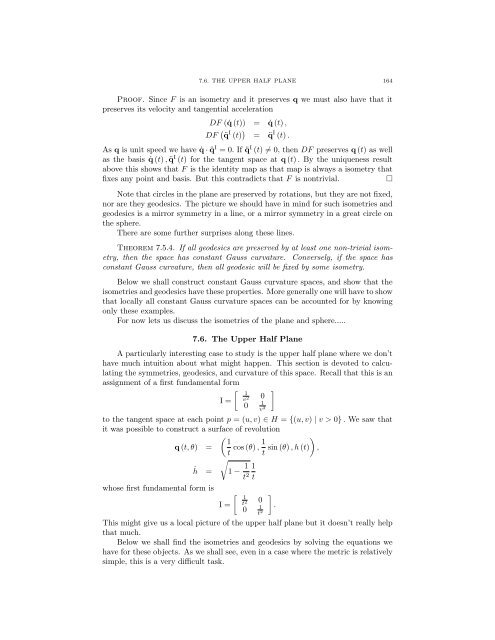Lecture Notes for 120 - UCLA Department of Mathematics
Lecture Notes for 120 - UCLA Department of Mathematics
Lecture Notes for 120 - UCLA Department of Mathematics
You also want an ePaper? Increase the reach of your titles
YUMPU automatically turns print PDFs into web optimized ePapers that Google loves.
7.6. THE UPPER HALF PLANE 164<br />
Pro<strong>of</strong>. Since F is an isometry and it preserves q we must also have that it<br />
preserves its velocity and tangential acceleration<br />
DF ( ˙q (t)) = ˙q (t) ,<br />
DF ¨q I (t) = ¨q I (t) .<br />
As q is unit speed we have ˙q · ¨q I =0. If ¨q I (t) 6= 0, then DF preserves q (t) as well<br />
as the basis ˙q (t) , ¨q I (t) <strong>for</strong> the tangent space at q (t) . By the uniqueness result<br />
above this shows that F is the identity map as that map is always a isometry that<br />
fixes any point and basis. But this contradicts that F is nontrivial.<br />
⇤<br />
Note that circles in the plane are preserved by rotations, but they are not fixed,<br />
nor are they geodesics. The picture we should have in mind <strong>for</strong> such isometries and<br />
geodesics is a mirror symmetry in a line, or a mirror symmetry in a great circle on<br />
the sphere.<br />
There are some further surprises along these lines.<br />
Theorem 7.5.4. If all geodesics are preserved by at least one non-trivial isometry,<br />
then the space has constant Gauss curvature. Conversely, if the space has<br />
constant Gauss curvature, then all geodesic will be fixed by some isometry.<br />
Below we shall construct constant Gauss curvature spaces, and show that the<br />
isometries and geodesics have these properties. More generally one will have to show<br />
that locally all constant Gauss curvature spaces can be accounted <strong>for</strong> by knowing<br />
only these examples.<br />
For now lets us discuss the isometries <strong>of</strong> the plane and sphere.....<br />
7.6. The Upper Half Plane<br />
A particularly interesting case to study is the upper half plane where we don’t<br />
have much intuition about what might happen. This section is devoted to calculating<br />
the symmetries, geodesics, and curvature <strong>of</strong> this space. Recall that this is an<br />
assignment <strong>of</strong> a first fundamental <strong>for</strong>m<br />
apple 1<br />
I= v<br />
0 2 1<br />
0<br />
v 2<br />
to the tangent space at each point p =(u, v) 2 H = {(u, v) | v>0} . We saw that<br />
it was possible to construct a surface <strong>of</strong> revolution<br />
✓ 1<br />
q (t, ✓) =<br />
t cos (✓) , 1 ◆<br />
t sin (✓) ,h(t) ,<br />
r<br />
1 1<br />
ḣ = 1<br />
t 2 t<br />
whose first fundamental <strong>for</strong>m is<br />
apple 1<br />
I= t<br />
0 2 1 .<br />
0<br />
t 2<br />
This might give us a local picture <strong>of</strong> the upper half plane but it doesn’t really help<br />
that much.<br />
Below we shall find the isometries and geodesics by solving the equations we<br />
have <strong>for</strong> these objects. As we shall see, even in a case where the metric is relatively<br />
simple, this is a very difficult task.
















